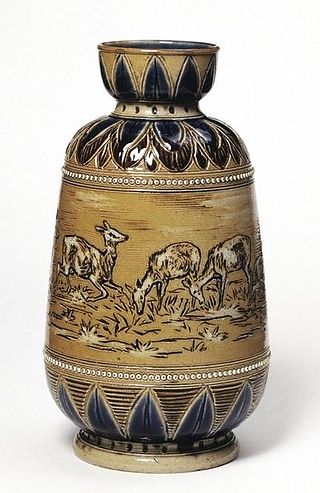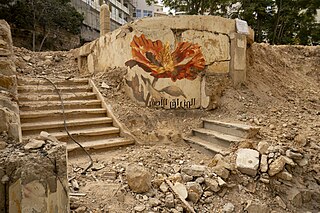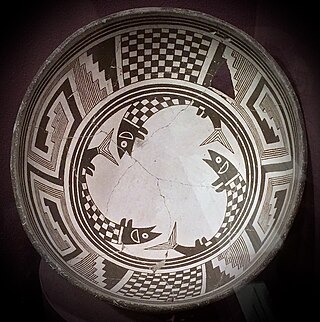
Pottery and porcelain is one of the oldest Japanese crafts and art forms, dating back to the Neolithic period. Kilns have produced earthenware, pottery, stoneware, glazed pottery, glazed stoneware, porcelain, and blue-and-white ware. Japan has an exceptionally long and successful history of ceramic production. Earthenwares were made as early as the Jōmon period, giving Japan one of the oldest ceramic traditions in the world. Japan is further distinguished by the unusual esteem that ceramics hold within its artistic tradition, owing to the enduring popularity of the tea ceremony.

A vase is an open container. It can be made from a number of materials, such as ceramics, glass, non-rusting metals, such as aluminium, brass, bronze, or stainless steel. Even wood has been used to make vases, either by using tree species that naturally resist rot, such as teak, or by applying a protective coating to conventional wood or plastic. Vases are often decorated, and they are often used to hold cut flowers. Vases come in different sizes to support whatever flower is being held or kept in place.

Korean ceramic history begins with the oldest earthenware from around 8000 BC. Throughout the history, the Korean peninsula has been home to lively, innovative, and sophisticated art making. Long periods of stability have allowed for the establishment of spiritual traditions, and artisan technologies specific to the region. Korean ceramics in Neolithic period have a unique geometric patterns of sunshine, or it is decorated with twists. In Southern part of Korea, Mumun pottery were popular. Mumun togi used specific minerals to make colors of red and black. Korean pottery developed a distinct style of its own, with its own shapes, such as the moon jar or Buncheong sagi which is a new form between earthenware and porcelain, white clay inlay celadon of Goryeo, and later styles like minimalism that represents Korean Joseon philosophers' idea. Many talented Korean potters were captured and brought to Japan during the invasions of Korea, where they heavily contributed to advancing Japanese pottery. Arita ware, founded by Yi Sam-pyeong opened a new era of porcelain in Japan. Another Japanese representative porcelain, Satsuma ware was also founded by Dang-gil Shim and Pyeong-ui Park. 14th generation of Su-kwan Shim have been using the same name to his grandfather and father to honor they are originally Korean, 14th Su-kwan Shim is honorable citizen of Namwon, Korea.

Studio pottery is pottery made by professional and amateur artists or artisans working alone or in small groups, making unique items or short runs. Typically, all stages of manufacture are carried out by the artists themselves. Studio pottery includes functional wares such as tableware and cookware, and non-functional wares such as sculpture, with vases and bowls covering the middle ground, often being used only for display. Studio potters can be referred to as ceramic artists, ceramists, ceramicists or as an artist who uses clay as a medium.

Wedgwood is an English fine china, porcelain and luxury accessories manufacturer that was founded on 1 May 1759 by the potter and entrepreneur Josiah Wedgwood and was first incorporated in 1895 as Josiah Wedgwood and Sons Ltd. It was rapidly successful and was soon one of the largest manufacturers of Staffordshire pottery, "a firm that has done more to spread the knowledge and enhance the reputation of British ceramic art than any other manufacturer", exporting across Europe as far as Russia, and to the Americas. It was especially successful at producing fine earthenware and stoneware that were accepted as equivalent in quality to porcelain but were considerably cheaper.

Royal Doulton is an English ceramic and home accessories manufacturer that was founded in 1815. Operating originally in Vauxhall, London, and later moving to Lambeth, in 1882 it opened a factory in Burslem, Stoke-on-Trent, in the centre of English pottery. From the start, the backbone of the business was a wide range of utilitarian wares, mostly stonewares, including storage jars, tankards and the like, and later extending to drain pipes, lavatories, water filters, electrical porcelain and other technical ceramics. From 1853 to 1901, its wares were marked Doulton & Co., then from 1901, when a royal warrant was given, Royal Doulton.

Fritware, also known as stone-paste, is a type of pottery in which frit is added to clay to reduce its fusion temperature. The mixture may include quartz or other siliceous material. An organic compound such as gum or glue may be added for binding. The resulting mixture can be fired at a lower temperature than clay alone. A glaze is then applied on the surface.

Adelaide Alsop Robineau (1865–1929) was an American china painter and potter, and is considered one of the top ceramists of American art pottery in her era.

Art pottery is a term for pottery with artistic aspirations, made in relatively small quantities, mostly between about 1870 and 1930. Typically, sets of the usual tableware items are excluded from the term; instead the objects produced are mostly decorative vessels such as vases, jugs, bowls and the like which are sold singly. The term originated in the later 19th century, and is usually used only for pottery produced from that period onwards. It tends to be used for ceramics produced in factory conditions, but in relatively small quantities, using skilled workers, with at the least close supervision by a designer or some sort of artistic director. Studio pottery is a step up, supposed to be produced in even smaller quantities, with the hands-on participation of an artist-potter, who often performs all or most of the production stages. But the use of both terms can be elastic. Ceramic art is often a much wider term, covering all pottery that comes within the scope of art history, but "ceramic artist" is often used for hands-on artist potters in studio pottery.

Chinese influences on Islamic pottery cover a period starting from at least the 8th century CE to the 19th century. This influence of Chinese ceramics has to be viewed in the broader context of the considerable importance of Chinese culture on Islamic arts in general.
Klytie Pate was an Australian studio potter who emerged as an innovator in the use of unusual glazes and the extensive incising, piercing and ornamentation of earthenware pottery. She was one of a small group of Melbourne art potters which included Marguerite Mahood and Reg Preston who were pioneers in the 1930s of ceramic art nationwide. Her early work was strongly influenced by her aunt, the artist and printmaker, Christian Waller.

Faith47 / Faith XLVII is a South African interdisciplinary artist. Her inaugeral museum exhibition CLAIR OBSUR took place at the Musee Des Beaux Arts de Nancy (2023). She has held solo exhibitions in Paris (2023), Cape Town (2021), Miami (2018), New York City (2015), London (2014) and Johannesburg (2012).
Athi-Patra Ruga is a South African artist who uses performance, photography, video, textiles, and printmaking to explore notions of utopia and dystopia, material and memory. His work explores the body in relation to sensuality, culture, and ideology, often creating cultural hybrids. Themes such as sexuality,Xhosa culture, and the place of queerness within post-apartheid South Africa also permeate his work.
Jack Doherty is a Northern Irish studio potter and author. He is perhaps best known for his vessels made of soda-fired porcelain. He has been featured in a number of books, and his work has been exhibited widely in both Europe and North America. Articles of his have appeared in various pottery journals and he has been Chair of the Craft Potters Association.

Ceramic art is art made from ceramic materials, including clay. It may take varied forms, including artistic pottery, including tableware, tiles, figurines and other sculpture. As one of the plastic arts, ceramic art is a visual art. While some ceramics are considered fine art, such as pottery or sculpture, most are considered to be decorative, industrial or applied art objects. Ceramic art can be created by one person or by a group, in a pottery or a ceramic factory with a group designing and manufacturing the artware.
iQhiya is a network of young black women artists based in Cape Town and Johannesburg, South Africa. They specialise in a broad range of artistic disciplines including performance art, video, photography, sculpture and other mediums.

Roger Michell was a British studio potter, artist, illustrator, poet and writer. Although foremost a potter, his deep insight, curiosity and his singular skills enabled him to work across a range of disciplines. He was a prolific reader, often reading several books a week. His mind was constantly working on future projects, he had a vivid and complex imagination which was evident in his work. He was most known for designing Walking Ware, a tea set on legs with over-sized Mary Jane shoes. During the nineteen seventies and eighties, thousands of these tea sets were sold, either hand made from Lustre Pottery studio or manufactured by Carltonware in Stoke-on-Trent.
Kofi Antubam, born in 1922, emerged as a trailblazing figure in the development of modern art in Ghana. His artistic journey commenced during his formative years, notably shaped by his education at Achimota School in the Gold Coast during the 1930s. This institution, recognized for its commitment to merging modern and African art, profoundly influenced Antubam's artistic perspective.

Pueblo pottery are ceramic objects made by the indigenous Pueblo people and their antecedents, the Ancestral Puebloans and Mogollon cultures in the Southwestern United States and Northern Mexico. For centuries, pottery has been central to pueblo life as a feature of ceremonial and utilitarian usage. The clay is locally sourced, most frequently handmade, and fired traditionally in an earthen pit. These items take the form of storage jars, canteens, serving bowls, seed jars, and ladles. Some utility wares were undecorated except from simple corrugations or marks made with a stick or fingernail, however many examples for centuries were painted with abstract or representational motifs. Some pueblos made effigy vessels, fetishes or figurines. During modern times, pueblo pottery was produced specifically as an art form to serve an economic function. This role is not dissimilar to prehistoric times when pottery was traded throughout the Southwest, and in historic times after contact with the Spanish colonialists.

The Montebello Design Centre is a non-profit art and craft space established in 1993 and located in Newlands, Cape Town, South Africa. The centre hosts over twenty craft workshops, shops, restaurants, and artist studios.















